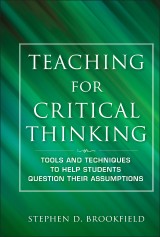Details

Teaching for Critical Thinking
Tools and Techniques to Help Students Question Their Assumptions1. Aufl.
|
34,99 € |
|
| Verlag: | Wiley |
| Format: | |
| Veröffentl.: | 18.10.2011 |
| ISBN/EAN: | 9781118146705 |
| Sprache: | englisch |
| Anzahl Seiten: | 304 |
DRM-geschütztes eBook, Sie benötigen z.B. Adobe Digital Editions und eine Adobe ID zum Lesen.
Beschreibungen
<p>While notions of what constitutes critical thinking vary, educators, politicians, and employers all agree that critical thinking skills are necessary for well-educated citizens and a key capacity for successful employees. In <i>Teaching for Critical Thinking,</i> Stephen Brookfield explores how students learn to think critically and what methods teachers can use to help. <p>In his engaging, conversational style, Brookfield establishes a basic protocol of critical thinking that focuses on students uncovering and checking assumptions, exploring alternative perspectives, and taking informed actions. The book fosters a shared understanding of critical thinking and helps all faculty adapt general principles to specific disciplinary contexts. <p>Drawing on thousands of student testimonies, the book identifies the teaching methods and approaches that are most successful when teaching students to think, read, and write critically. Brookfield explains when to make critical thinking the classroom focus, how to encourage critical discussions, and ways to reach skeptical students. He outlines the basic components required when reviewing a text critically and shows how to give highly specific feedback. <p>The book also addresses how to foster critical thinking across an institution, beginning with how it can be explained in syllabi and even integrated into strategic plans and institutional missions. Brookfield stresses the importance of teachers modeling critical thinking and demonstrates himself how to do this. <p>Crammed with activities and techniques, this how-to guide is applicable in face-to-face, online, and hybrid classrooms of all sizes. Each exercise includes detailed instructions, examples from different academic disciplines, and guidance for when and how to best use each activity. Any reader will come away with a pedagogic tool kit of new ideas for classroom exercises, new approaches to designing course assignments, and new ways to assess students’ ability to practice critical analysis.
<p>Preface vii</p> <p>About the Author xvii</p> <p>1 What is Critical Thinking? 1</p> <p>2 Critical Thinking Across the Disciplines 27</p> <p>3 How Critical Thinking is Learned 53</p> <p>4 Introducing Basic Protocols of Critical Thinking 77</p> <p>5 Developing Critical Complexity: Intermediate and Advanced Protocols 105</p> <p>6 Reading and Writing Critically 129</p> <p>7 Integrating Critical Thinking Across the Curriculum 155</p> <p>8 Making Discussions Critical 179</p> <p>9 Misunderstandings, Challenges, and Risks 205</p> <p>10 Modeling Critical Thinking 233</p> <p>References 261</p> <p>Index 269</p>
<p>THE AUTHOR</p> <p><b>STEPHEN D. BROOKFIELD </b>is Distinguished University Professor at the University of St. Thomas in Minneapolis, Minnesota. For forty years he has taught in the United States and abroad. A four-time winner of the Cyril O. Houle Award for Outstanding Literature in Adult Education, he is the author of numerous books on teaching, including <i>The Skillful Teacher</i> and <i>Developing Critical Thinkers. </i>
<p>While notions of what constitutes critical thinking vary, educators, politicians, and employers all agree that critical thinking skills are necessary for well-educated citizens and a key capacity for successful employees. In <i>Teaching for Critical Thinking,</i> Stephen Brookfield explores how students learn to think critically and what methods teachers can use to help. <p>In his engaging, conversational style, Brookfield establishes a basic protocol of critical thinking that focuses on students uncovering and checking assumptions, exploring alternative perspectives, and taking informed actions. The book fosters a shared understanding of critical thinking and helps all faculty adapt general principles to specific disciplinary contexts. <p>Drawing on thousands of student testimonies, the book identifies the teaching methods and approaches that are most successful when teaching students to think, read, and write critically. Brookfield explains when to make critical thinking the classroom focus, how to encourage critical discussions, and ways to reach skeptical students. He outlines the basic components required when reviewing a text critically and shows how to give highly specific feedback. <p>The book also addresses how to foster critical thinking across an institution, beginning with how it can be explained in syllabi and even integrated into strategic plans and institutional missions. Brookfield stresses the importance of teachers modeling critical thinking and demonstrates himself how to do this. <p>Crammed with activities and techniques, this how-to guide is applicable in face-to-face, online, and hybrid classrooms of all sizes. Each exercise includes detailed instructions, examples from different academic disciplines, and guidance for when and how to best use each activity. Any reader will come away with a pedagogic tool kit of new ideas for classroom exercises, new approaches to designing course assignments, and new ways to assess students’ ability to practice critical analysis.

















